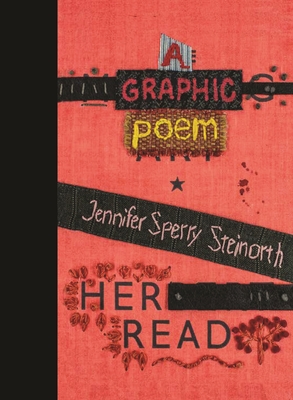A Graphic Poem
Jennifer Sperry Steinorth
Texas Review Press ($29.95)
by Joel Turnipseed
Early in her book-length erasure of Herbert Read’s The Meaning of Art, Jennifer Sperry Steinorth reveals one of the aims of her project—“Distort/the given world”—and clears out space for the shock of new recognitions: “Even/Aphrodite/is difficult.” Of course, the world being distorted is one in which women have been erased throughout—or presented only as the subject of the male gaze and its concomitant reveries. In Her Read, the odalisque snatches back the brush and pen (and Wite-Out) to stretch a new canvas: one punctuated with thread and blood from pricked fingers, possessed of its own desire and fully possessing a body hungry for iron.
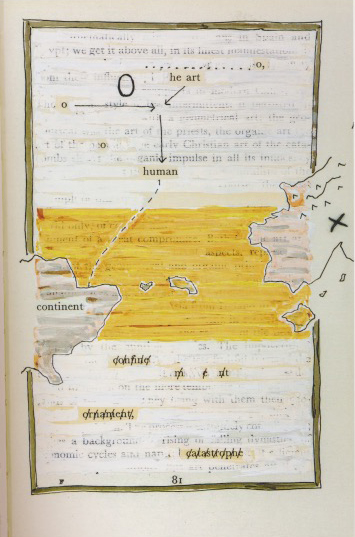
Over the 240 pages in which Steinorth tropes the very idea of “erasure” in reclaiming womxn’s representation and participation in art, she clears spaces for hope, joy, and the real work of living in and with pain, this latter most insistently: “I would like to free / colour / and so emancipate / my / shadow / from this / connoisseur’s enthusiasm for pain.” Hers is no scholar’s pain, no writing on the anguish of another subject, but a gloriously full-throated song of direct experience. She contrasts Read’s armchair celebrations of despair and struggle (referring to him throughout as “Imp”) with her reclamation of the fully fleshed self, realized in “R skin.” As the Imp and R Skin appear on page after page, the dialogue becomes something of an invitation to a new forthrightness: “I / may / step / out / with / the devil / to / escape /no no no / to / be amused at / the / ambition / of / tombs.”
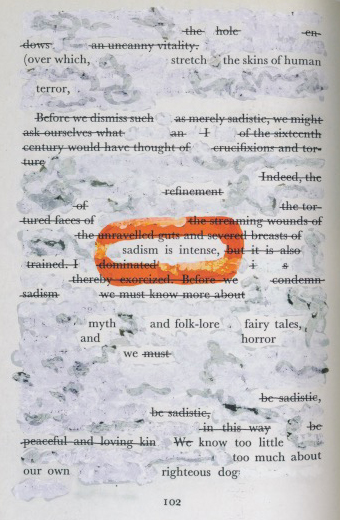
Steinorth’s poetic techniques are empowered by correction fluid, embroidery, ball-point, brush wash, collage, Sharpie, and her own blood, making her engagement with Read’s Meaning truly visceral. This is a handiwork of necessity, making its voice from what is at-hand, carrying around work for the time when it can be accomplished—for and by a body that knows what it is like for one body to give forth not just a work, but another body. This is the work of informed creation: it knows itself and its efforts. There are great sections where the techniques of erasure continue the work of making the poetry physical, as when a scalpel is brought to bear on a tableau of Abraham and Isaac: “please /let / us! /re / fashion / the story.”
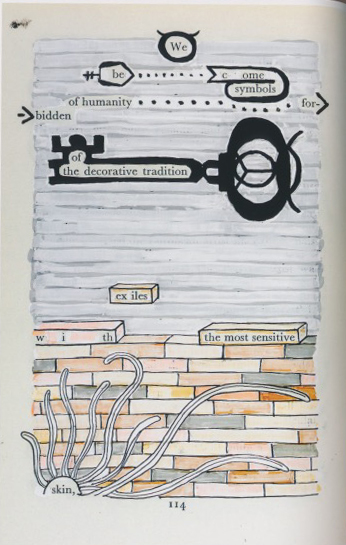
The work of refiguring the world of art and its meanings is vast, of course, yet Her Read does a wonderful job of tackling it in specifics, and especially in the opportunities brought to bear by erasure’s discovery of new worlds within the old words. Here, language is not the limit of the world, but a forest of signposts on the way (though often in desperate need of maintenance): “O, he art/o / o / human / continent / confine / ment / ornament / catastrophe.” Steinorth’s clearings can be hilarious, righteous, and sometimes just blunt: “NO.” Throughout, the book builds from its initial argument with Read and his patriarchy toward an engagement with just what an art that respects the bodies which produce and encounter it might require. A new sense of honesty, for one, about the pain we consume in art: “(over which, stretch the skins of human / terror, / sadism is intense / myth and folk-lore fairy tales, / and horror/we / know too little / too much about / our own righteous dog.”
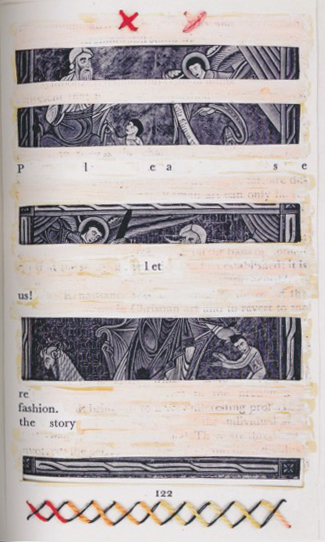
A (mostly implicit) question that Steinorth’s work raises again and again as it confronts Read’s erasures of womxn is: “What kinds of erasures are worth undertaking—and how should we go about them?” In explicitly foregrounding her engagement with Read’s erasure of womxn in The Meaning of Art, she offers that there will always be a kind of violence in erasure, even where it is a necessary labor (as, say, birth is often traumatic). In making her offering, she avers that in any wreckage there may still be a thread worth saving, possibly with delicacy in the attempt. She clearly spent years chasing that thread, building up Her Read—”an embroidered wound.”
Erasure is an almost limitless technique, but it is one best served by the richness or expansiveness of the possibilities of its specific encounters. When Tom Phillips and R B Kitaj walked into that thrift store to find W. H. Mallock’s A Human Document, already waiting for Mallock’s florid prose was Phillips’ incisive wit and spirit for detournement—which gave us one of erasure’s greatest wonders, A Humument. Jennifer Sperry Steinorth is similarly matched to her material, taking Herbert Read’s The Meaning of Art as a medium for a revelatory remaking of the sites of meaning, of the possibilities of art made by womxn in the fullness of their bodies. Her Read is a transfixing journey from the outrage of one form of erasure to the boundless possibilities for discovery and invention contained in another.
Click here to purchase this book at your local independent bookstore
Rain Taxi Online Edition Summer 2022 | © Rain Taxi, Inc. 2022

